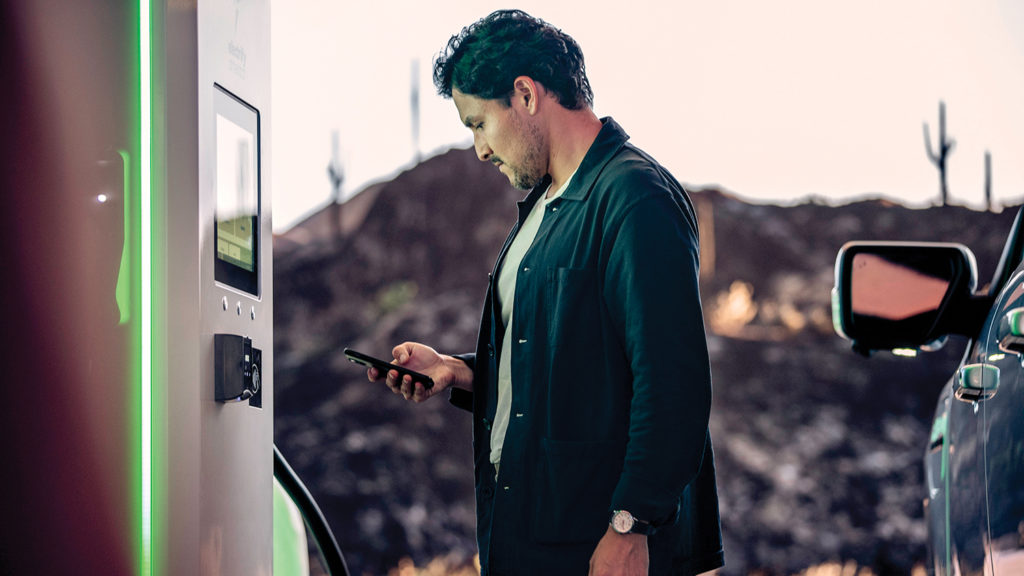By Derrill Holly

Utilities, including electric cooperatives, will be serving new electric vehicle (EV) load and extending the reach of public charging networks now under development or proposed for major transportation corridors.
“Electric vehicles are evolving rapidly and, as they do, use and charging patterns are shifting and consumers are getting a better understanding of how they can use the vehicles,” says Brett Smith, director of technology for the Center for Automotive Research. The non-profit organization conducts independent research on behalf of the global mobility industry.
Still, one of the major challenges facing market acceptance remains a lack of charging infrastructure in many parts of the country. As of December 2021, there were about 113,000 charging ports available at 46,090 public charging stations nationwide.
“You’re going to see the need to really invest in infrastructure over the next five to 10 years,” says Smith, adding that some buyers who have the option of home charging have not reached the comfort level essential to use EVs for longer trips. “They don’t see the infrastructure out there. You’re probably at some point going to need to make it seem like overinvestment, because you have to make the consumer comfortable.”
The federal government estimates that 500,000 public chargers will be needed by 2030, and it is currently investing $7.5 billion to help build a network of public chargers along major highways and in rural areas. The funding comes from the bipartisan infrastructure bill passed by Congress and signed into law last November.
According to the Department of Energy, the majority of ports now being deployed for public use are DC fast chargers that provide 60 to 80 miles of range for 20 minutes of charging time, compared to four minutes at the pump for most gasoline-powered vehicles.
Smith said it may be feasible to charge EVs up to 80% of capacity in about 15 minutes.
“Whether that’s perfect for everybody or not, if it becomes a standard or an accepted practice, I think people could become comfortable with that,” he says.
The Joint Office for Electric Vehicle Charging and Infrastructure operated by the Department of Energy and the Department of Transportation is developing a grant program to help states and local partners, including electric co-ops, develop public charging facilities.
“NRECA and electric cooperatives formed the Community Approach to Vehicle Electrification funding interest group. This group of co-ops is focused on using their detailed knowledge of local needs to address vehicle electrification and charging infrastructure,” says Brian Sloboda, NRECA’s director of consumer solutions.
Across the U.S., many electric cooperatives are already in regular contact with their state departments of transportation (DOTs) to discuss current and proposed Alternative Fuel Corridors. These corridors will be the areas eligible for federal funding. State DOTs must submit an EV infrastructure plan to the federal government by August 1, 2022.
“Electric co-ops can help their (state)DOTs by identifying areas of the service territory where EV charging infrastructure could be placed in an economic manner that overlap with current or proposed Alternative Fuel Corridors,” says Sloboda.
Under the bipartisan Infrastructure Investment and Jobs Act, public EV charging infrastructure should be located every 50 miles along major travel corridors, and no more than 1 mile from the highway.
“The focus on local needs will ensure that the college tailgate parties, national parks, highway interchanges, local businesses and county fairs are adequately represented,” says Sloboda. “They will place the infrastructure where the people and local businesses are.”
The DOE’s Alternate Fuels Data Center has developed a Station Locator Tool (SLT) mobile app. During the government’s 2021 fiscal year, the SLT site attracted 6 million page views and topped 3,900 downloads. According to the DOE, the site provided more than 1.3 million searches for EV charging stations for the fiscal year.
Drive Electric Alabama promotes EV usage
In Alabama, a program called Drive Electric Alabama is the official statewide initiative coordinated by the Alabama Department of Economic and Community Affairs (ADECA) designed to educate consumers, utility regulators, and government officials about electric vehicles. ADECA has developed a statewide Electric Vehicle Infrastructure Plan (EVIP) to guide the deployment of state resources for an EV charging infrastructure. In June 2021, the state combined funds appropriated by the legislature with Volkswagen settlement funds, and ADECA awarded 18 grants totaling more than $4.1 million to finance the installation of several charging stations to be installed in 2022. The EVIP notes that this will more than double the number of publicly accessible fast charger locations statewide. Locations are predominantly along the I-20/I-59/I-459 corridor between Tuscaloosa and the Georgia state line. For more information, see driveelectric.alabama.gov.




